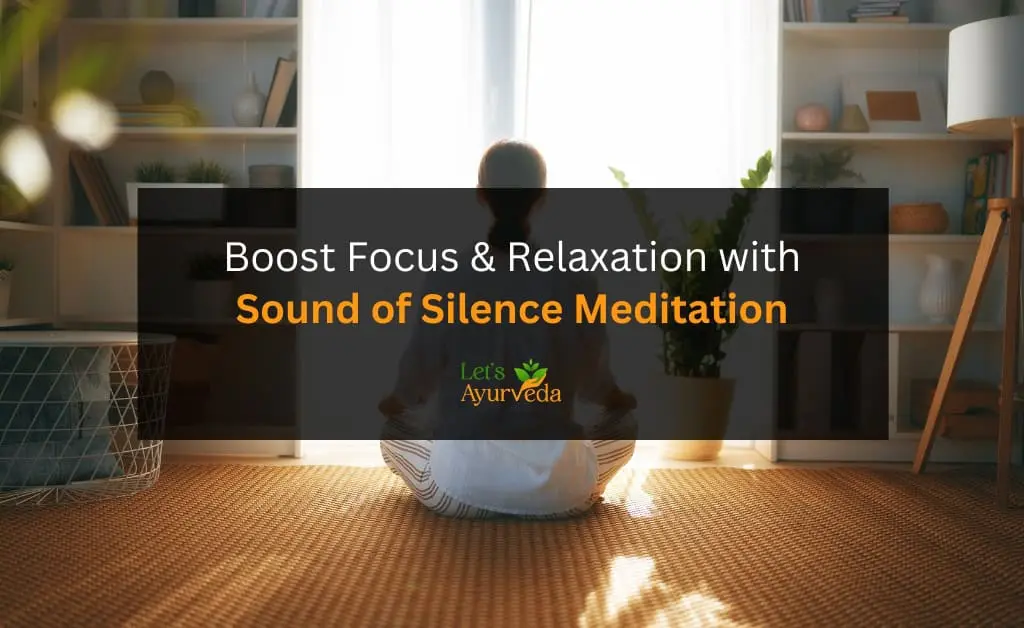Imagine sitting in complete stillness, surrounded by silence, yet tuning into a powerful, calming sound within you. This experience is what "Sound of Silence Meditation" offers—a profound technique that’s quickly gaining attention for its ability to bring a sense of peace, clarity, and healing. But what exactly is this form of meditation, and how can it benefit you? Let's explore everything you need to know about Sound of Silence Meditation, its roots, benefits, and how it can be integrated into your daily life for transformative effects.
What Is Sound of Silence Meditation?
Sound of Silence Meditation, often referred to as "Nada Meditation," centers on the idea of tuning into the inner sounds that naturally arise within our minds when we sit in silence. This inner sound can manifest as a soft ringing, hum, or vibration, often called the "sound of silence." Originating from ancient practices, Nada Yoga—the “yoga of sound”—aims to merge the mind and soul through sound. Unlike other forms of meditation that might use external guides, music, or mantras, Sound of Silence Meditation turns the focus inward, encouraging us to listen to what’s already there.
Why the "Sound of Silence"?
Every day, we’re bombarded by external noise—traffic, conversations, digital notifications—all adding to our stress and mental overload. This meditation counters this by helping us tap into the calming, quieter side of our inner world, a natural antidote to the noise outside. In this way, Sound of Silence Meditation isn’t just about finding quiet in our environment; it’s about cultivating an inner quiet that we can carry with us, no matter how chaotic things become around us.
The Science Behind Sound of Silence Meditation
While there isn’t a wealth of studies specifically focused on Sound of Silence Meditation, research on similar meditative practices shows promising effects:
-
Reduces Stress and Anxiety: Meditation techniques focusing on sound and silence have been shown to reduce cortisol levels, our body’s stress hormone. A study published in JAMA Internal Medicine found that people who practiced mindfulness-based stress reduction (MBSR) techniques, which include silent meditation, reported a 38% decrease in anxiety and a 45% improvement in emotional resilience.
-
Improves Focus and Concentration: Regular meditation focusing on inner sounds trains the brain to concentrate on subtle, consistent inputs. This deep concentration boosts cognitive skills, making you more focused and attentive during daily tasks.
-
Aids Emotional Healing: When we sit in silence and truly listen to our inner self, we often confront underlying emotions we may have suppressed. Studies show that meditative practices focused on mindfulness and silence help in emotional healing, reducing symptoms of depression by 30% in participants after eight weeks of consistent practice.
These benefits are similar across many forms of meditation, but Sound of Silence offers a unique approach that emphasizes our relationship with inner stillness and sound.
How to Practice Sound of Silence Meditation
Ready to try it? Here’s a step-by-step guide to get started:
-
Find a Quiet Spot: Choose a comfortable, quiet space where you won’t be disturbed. You could sit cross-legged on the floor or in a chair with your back straight.
-
Close Your Eyes and Relax: Close your eyes and take a few deep breaths to release tension. Focus on relaxing every part of your body, from your head to your toes.
-
Tune Inward and Listen: Shift your attention to any subtle sound within your mind or body. You might hear a faint hum, ringing, or pulse. This is the "sound of silence" you’ll focus on.
-
Focus on the Sound: With your attention on this inner sound, let it become the anchor of your meditation. Thoughts might drift in, but gently bring your focus back to the sound without judgment or frustration.
-
Continue for 10-20 Minutes: Start with 10 minutes, gradually increasing to 20 minutes as you feel more comfortable. Over time, this practice will allow you to reach deeper states of calm and clarity.
Key Benefits of Sound of Silence Meditation
-
Promotes Deep Relaxation
Sound of Silence Meditation promotes a relaxation response that combats stress. This response reduces blood pressure and slows down the heart rate, making it ideal for those dealing with chronic stress or anxiety. Studies show that participants practicing silence-based meditation experienced a drop in blood pressure by as much as 5-10 mmHg.
-
Boosts Mental Clarity and Focus
Regular practice of this meditation style enhances concentration and focus. Focusing on subtle sounds improves our ability to pay attention, a skill that translates into sharper focus in our day-to-day lives. Research indicates that meditation improves memory and attention span, potentially increasing productivity by 22%.
-
Improves Sleep Quality
By cultivating calmness, Sound of Silence Meditation helps reduce insomnia. It slows down the mind's overactive state, allowing for better relaxation and sleep. One study found that participants practicing meditation for just six weeks reported a 50% improvement in sleep quality.
-
Enhances Emotional Awareness
Sound of Silence Meditation can help you get in touch with your feelings, even those buried deep within. This introspective practice often brings suppressed emotions to the surface, allowing for emotional release and healing. Studies on mindfulness practices reveal that people who meditate regularly are 40% more likely to experience improved mood and emotional stability.
-
Strengthens the Sense of Inner Peace
The simplicity of this practice brings us back to our own center. This type of meditation helps us become more aware of our natural inner state, fostering a sense of peace that lasts beyond the meditation session. The more we practice, the stronger this peace becomes, helping us respond to life’s ups and downs with calmness and resilience.
Tips for Getting the Most Out of Sound of Silence Meditation
-
Practice Consistently: Aim to practice at least 10 minutes every day. Consistency is key in deepening the benefits and making meditation a natural part of your routine.
-
Be Patient: It might take some time to tune into your inner sounds. Don’t worry if you don’t hear anything right away; just sit with the intention, and gradually, the sounds will emerge.
-
Focus on Progress, Not Perfection: Some days will be easier than others. The goal is progress, not perfection, so just enjoy the journey.
-
Experiment with Different Durations: While starting with 10 minutes is good, try to increase the time gradually, especially as you feel more comfortable. Longer sessions can lead to deeper experiences of calm and clarity.
Final Thoughts
If you’re ready to experience a quieter, more peaceful mind, Sound of Silence Meditation is a great place to start. Not only does it help you step away from the daily chaos, but it also connects you to a source of calm and clarity that resides within you. So, why not give it a try today? After all, sometimes the most profound answers lie in the quietest places.






